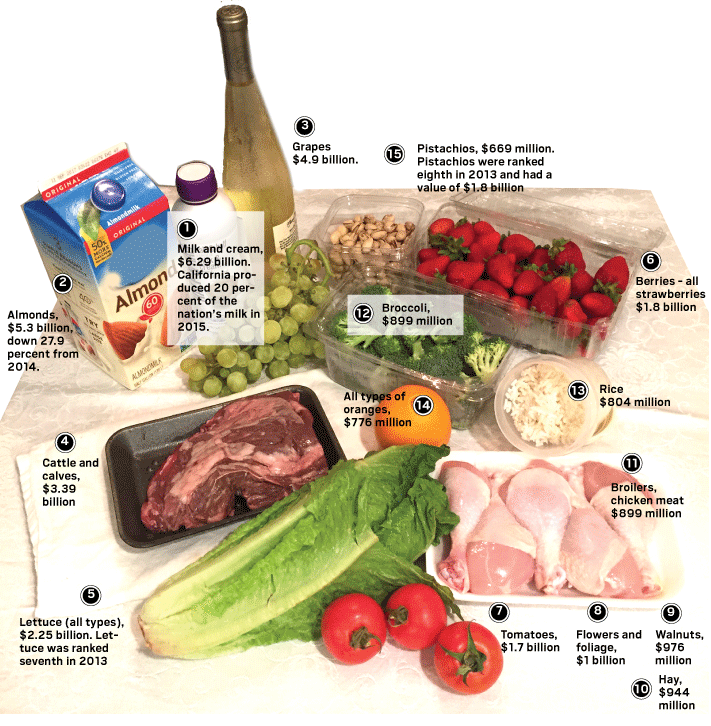Farm To Fork Column
By Victor Martino
It’s time to hang a lantern on California Agriculture and celebrate it
When the average American thinks about California, their first thoughts turn to Silicon Valley, that marvel of high-technology, Hollywood, the world’s entertainment capital, the fun and excitement of Disneyland, and the majestic Golden Gate Bridge.
I don’t intrinsically have a problem with this. After all, these are iconic examples of the Golden State. But it’s a shame California agriculture doesn’t come immediately to mind when the word California is uttered to most folks here at home and throughout the world. After all, the Golden State is the nation’s, and to a large degree the world’s, breadbasket.
For example, California’s 77,500 farms produce more than 400 commodities, and two-thirds of the nation’s fruits and nuts. Additionally, about one-quarter of what California produces is exported around the world. We’re global.
Not impressed yet? Here are a few other facts about farming in California.
California’s agricultural cash receipts are first in the nation — and are a whopping $20 billion more than the second highest-ranked state.
To put this in perspective, the Golden State’s cash receipts equal more than those of these 10 other western U.S. states combined: Washington, Oregon, Nevada, Arizona, New Mexico, Utah, Colorado, Idaho, Wyoming and Montana.
Still not impressed?
Well then, take a look at the items in the table below. It shows some of California’s top-15 valued crops. Each item is ranked with its estimated total gross dollar value. Impressive indeed.
California farmers also produce 99 percent of the following crops in the U.S.: artichokes, almonds, walnuts, pistachios, figs, olives, peaches, plums, kiwi fruit, dates, pomegranates, raisins and sweet rice.
Now that’s truly impressive.
The reality is that without California agriculture the nation’s food choices would be seriously limited. The Golden State is America’s breadbasket. It’s truly an agricultural phenomenon.
So why is it the marvel that is California agriculture is taken for granted? After all, Disneyland is truly a fun and wonderful place — but you can live without it. On the other hand, living without the 400-plus crops grown in the Golden State would amount to a life far less fulfilling, not to mention a shortage of food nationally and globally.
There are I think a number of reasons for this.
First, California farmers and its agribusiness industry are so good and so efficient at what they do that the marvel that is agriculture in the Golden State is simply taken for granted.
Most people don’t understand what it takes to grow crops in California — the hard work, the fight for water, the regulatory environment, labor issues. Rather, they take it for granted that it must not be all that difficult since year-after-year, crop-after-crop, the state’s farmers produce.
The State of California shares part of the responsibility for the lack of attention given to agriculture. For example, the Central Valley, which itself produces more gross farm crops than any other region in the nation, is neglected in Sacramento. The State Legislature shows a coastal bias towards Southern California to the south and the San Francisco Bay Area to the north. The vast and productive Central Valley north-to-south is most often viewed by those in power as that place along the interstate, a series of road signs with the names of farm towns on them.
The reality though is that agriculture generates about $50 billion annually for the California economy. If you include the related agribusiness and food processing industries, which wouldn’t exist were it not for farming, you can add tens of billions more on to this amount.
Another reason agriculture gets scant attention in California is the fault of those of us who are involved in the industry. We simply don’t sing its praises well enough and often enough. Perhaps we’ve come to take the marvel of California agriculture for granted a bit ourselves?
At the 1939 San Francisco World’s Fair, held at Treasure Island in San Francisco, the then California Department of Agriculture (the word food wasn’t included in the agency’s name back then) presented an exhibit called, “The History of California Agriculture.” The exhibit chronicled the Golden State’s agricultural marvels up until that time, touting its benefits to the state, the nation and the world. Among the highlights included this fact (as of 1939): “The state’s agricultural value exceed $600,000,000 annually.” Today that figure is more than $50 billion.
Fast-forward 100 years. This year the California Department of Food and Agriculture is celebrating its 100th anniversary as a state agency, a true milestone.
My suggestion to the California agricultural community is we use this milestone anniversary to hang a lantern on California ag, to communicate and tout what a marvel it is to Californians, the nation and the world. We need to celebrate it.
Let’s improve and increase the quality and frequency of our messaging and communication about agriculture in the Golden State.
Let’s demand of our elected officials that they pay more attention to farming in California and to places like the Central Valley, America’s breadbasket.
Let’s organize a symposium on California agriculture, where we elevate it as an industry equal to Silicon Valley and Hollywood here in California.
There is a great story to tell when it comes to California agriculture. The reality though is we aren’t telling it well enough and often enough.
It’s time to redouble our efforts in this regard. California agriculture deserves a more prominent seat at the dinner table. It’s up to those of us involved in the industry to make sure we get it.
The 100th anniversary of the California Department of Food and Agriculture this year is the perfect starting point for a renewed effort to elevate California agriculture in a way it truly deserves.
Let’s get busy.







